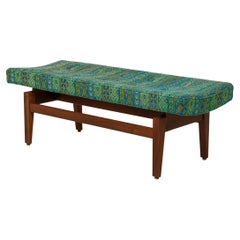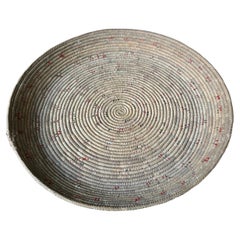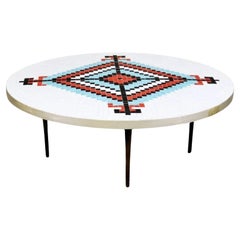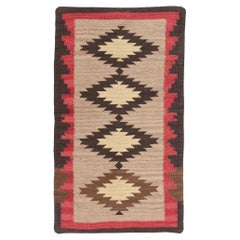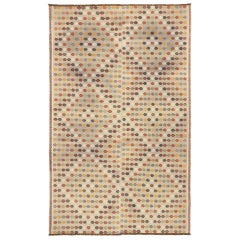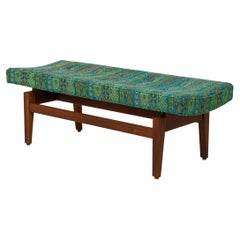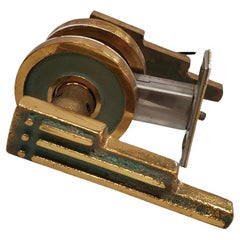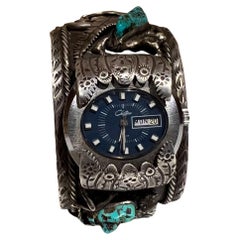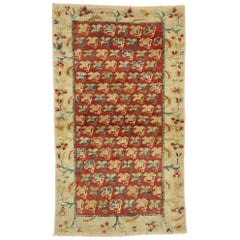Mid Century Modern Southwestern
Mid-20th Century Mid-Century Modern Benches
Wood
Mid-20th Century American Decorative Bowls
Seagrass
Mid-20th Century Mid-Century Modern Coffee and Cocktail Tables
Ceramic
Early 20th Century American Mid-Century Modern North and South American ...
Wool
Mid-20th Century Turkish Industrial Turkish Rugs
Wool
20th Century Danish Mid-Century Modern Ottomans and Poufs
Fabric, Upholstery, Wood
Mid-20th Century American Mid-Century Modern Doors and Gates
Brass
Vintage 1970s Mid-Century Modern Collectible Jewelry
Stone, Silver
Mid-20th Century Turkish Oushak Turkish Rugs
Wool
21st Century and Contemporary Pakistani Oushak Turkish Rugs
Wool
Mid-20th Century Persian Kilim Persian Rugs
Wool
Early 20th Century Turkish Heriz Serapi Persian Rugs
Wool
Mid-20th Century Persian Tribal Persian Rugs
Wool
Mid-20th Century American Mid-Century Modern Cabinets
Metal
Mid-20th Century Afghan Mid-Century Modern Central Asian Rugs
Wool
Mid-20th Century Afghan Mid-Century Modern Central Asian Rugs
Wool
Late 20th Century Unknown Post-Modern Dining Room Tables
Glass, Plaster, Oak
Mid-20th Century Persian Heriz Serapi Persian Rugs
Wool
Mid-20th Century Afghan Aesthetic Movement Central Asian Rugs
Wool
Mid-20th Century Persian Heriz Serapi Persian Rugs
Wool
Mid-20th Century Persian Heriz Serapi Persian Rugs
Wool
Mid-20th Century Turkish Oushak Turkish Rugs
Wool
Mid-20th Century Turkish Oushak Turkish Rugs
Wool
Mid-20th Century Turkish Oushak Turkish Rugs
Wool
Mid-20th Century Turkish Oushak Turkish Rugs
Wool
Mid-20th Century Turkish Oushak Turkish Rugs
Wool
Mid-20th Century Turkish Oushak Turkish Rugs
Wool
Late 20th Century Moroccan Modern Moroccan and North African Rugs
Wool
Mid-20th Century Turkish Spanish Colonial Turkish Rugs
Wool
Late 20th Century Turkish Kilim Turkish Rugs
Silk
Late 20th Century Turkish Oushak Turkish Rugs
Wool
Late 20th Century Indian American Classical Indian Rugs
Wool
Late 20th Century Afghan Kilim Central Asian Rugs
Wool
21st Century and Contemporary Indian Tribal Indian Rugs
Wool
Early 20th Century Persian Heriz Serapi Persian Rugs
Wool
Early 20th Century Persian Heriz Serapi Persian Rugs
Wool
21st Century and Contemporary Pakistani Oushak Turkish Rugs
Wool
Antique Late 19th Century Persian Serapi Persian Rugs
Wool
Early 20th Century Persian Tribal Persian Rugs
Wool
Early 20th Century Persian Malayer Persian Rugs
Wool
Early 20th Century Persian Federal Persian Rugs
Wool
Mid-20th Century Afghan Kilim Central Asian Rugs
Wool
21st Century and Contemporary American Mid-Century Modern Floor Lamps
Ceramic
Late 20th Century Unknown Mid-Century Modern Chandeliers and Pendants
Metal
Mid-20th Century North American Mid-Century Modern Shelves and Wall Cabi...
Plaster, Wood
Vintage 1970s American Mid-Century Modern Paintings
Gesso, Paint
20th Century American Mid-Century Modern Side Tables
Steel
Mid-20th Century American Mid-Century Modern Table Lamps
Ceramic, Paint
Mid-20th Century American Mid-Century Modern Table Lamps
Ceramic
20th Century Danish Scandinavian Modern Buffets
Teak, Glass
Early 20th Century Persian Bakshaish Persian Rugs
Wool
Antique Late 19th Century Persian Sultanabad Persian Rugs
Wool
Mid-20th Century Persian Heriz Serapi Persian Rugs
Wool
Antique 19th Century Victorian Armchairs
Fabric, Wood
Mid-20th Century Turkish Oushak Turkish Rugs
Wool
Late 20th Century Turkish Mid-Century Modern Turkish Rugs
Wool
Mid-20th Century Turkish Kilim Turkish Rugs
Wool
Late 20th Century Danish Scandinavian Modern Cabinets
Wood, Teak, Paint
Late 20th Century Danish Scandinavian Modern Credenzas
Teak
Late 20th Century Danish Scandinavian Modern Cabinets
Glass, Teak
- 1
Mid Century Modern Southwestern For Sale on 1stDibs
How Much is a Mid Century Modern Southwestern?
Finding the Right Rugs And Carpets for You
Good antique rugs and vintage rugs have made their way into homes across the globe, becoming fixtures used for comfort, prayer and self-expression, so choosing the right area rug is officially a universal endeavor.
In modern usage, “carpet” typically denotes a wall-to-wall floor cushioning that is fixed to the floor. Rugs, on the other hand, are designed to cover a specific area and can easily be moved to new locations. However, the terms are interchangeable in many parts of the world, and, in the end, it won’t matter what you decide to call it.
It’s well known that a timeless Persian rug or vintage Turkish rug can warm any interior, but there are lots of other styles of antique rugs to choose from when you're endeavoring to introduce fresh colors and textures to a bedroom or living room.
Moroccan Berber rugs are not all about pattern. In fact, some of the most striking examples are nearly monochrome. But what these rugs lack in complexity, they make up for in brilliant color and subtle variation. Moroccan-style interiors can be mesmerizing — a sitting room of this type might feature a Moroccan rug, carved wooden screens and a tapestry hung behind the sofa.
Handwoven kilim rugs, known for their wealth of rich colors and unique weaving tradition, are pileless: Whereas the Beni Ourain rugs of Morocco can be described as dense with a thick surface or pile, an authentic kilim rug is thin and flat. (The term “kilim” is Turkish in origin, but this type of textile artistry is practiced all across the Balkans, throughout the Arab world and elsewhere.)
When it comes to eye-catching floor coverings, the distinctive “medallion” pattern of Oushak rugs has two types of rounded shapes alternating against a rich red or blue background created with natural dyes, while the elaborate “star” pattern involves large eight-pointed shapes in diagonal rows alternating with diamonds.
If you’re looking for something unexpected, find a runner rug that pops in your hallway or on your stairs. Dig for dazzling geometric patterns in our inventory of mid-century modern rugs and carpets, which includes works designed by the likes of Swedish textile masters Märta Måås-Fjetterström, Marianne Richter and other artisans.
Carpets and rugs have been around for thousands of years. Prehistoric humans turned to animal skin, wool and fur to craft simple fabrics to soften hard terrain. A 2016 study suggests that "cave lions" were hunted for exactly this purpose, and that decorating your cave with their pelts may have conferred strength and prestige. Although many of these early textiles are still in existence, tracing their precise origins is difficult. Carpets quickly became such a valuable trade commodity that the weavings could easily travel far from their places of origin.
The oldest known carpet was found in southern Siberia. (It may have traveled there from Persepolis in Iran.) For the flat-weave floor rugs crafted by Native Americans, cotton was the primary material before sheep’s wool was introduced in the 16th century. In Europe, carpet-making was fundamental to folk art, and Asian carpets imported to European countries were at one time considered a precious luxury and not intended to remain permanently on the floor.
With the variety of area rugs and carpets rolled out for you on 1stDibs — a collection that includes traditional, modern, minimalist rugs and other coverings of all kinds — things will be looking up whenever you’re looking down.
- 1stDibs ExpertFebruary 27, 2024The difference between mid-century and mid-century modern comes down to specificity. When it comes to furniture and architecture, for example, mid-century refers to works that emerged during the middle of the 20th century, usually between 1950 and 1970. The more specific descriptor, mid-century modern, is used to refer to a particular style of design that emphasizes simplicity, organic forms and clean lines. Mid-century modern furniture designers generally drew on the architectural work of Frank Lloyd Wright, Bauhaus design, Scandinavian modernism and more. Any piece of furniture produced during the 1950s and ’60s can be referred to as mid-century, but only those with specific characteristics are mid-century modern. That said, when enthusiasts of furniture and architecture use the shorter of the two phrases, they may indeed be referring to modernist works created during that period in history. On 1stDibs, find a wide variety of mid-century modern furniture.
- 1stDibs ExpertFebruary 22, 2021Most experts agree that mid-century modern correlates specifically to the years following World War II. It has grown in popularity in the decades since, particularly due to the media and cultural institutions that have promoted the truly innovative era of design. Not only did the MoMA promote modern furniture, but pieces are prominently visible on the set of very popular television shows such as Mad Men. Shop a wide and beautiful range of mid-century modern furniture on 1stDibs.
- Is rattan mid-century modern?1 Answer1stDibs ExpertMarch 13, 2024Yes, some rattan is mid-century modern. Designers of the mid-century modern movement often preferred to use natural materials, including rattan, in their designs. However, not all rattan furniture was made during this period. Rattan was also a popular material for furniture produced during the Victorian era and continues to be used to produce furniture today. Shop a wide range of rattan furniture on 1stDibs.
- Is Mondrian mid century modern?1 Answer1stDibs ExpertApril 5, 2022Yes, Mondrian’s art is believed to be one of the great inspirations for the mid-century modern approach to minimalism. His artworks were not just a departure from figurative works, but a new look at abstract art as well. On 1stDibs, find a variety of original artwork from top artists.
- Is mid-century modern timeless?1 Answer1stDibs ExpertApril 22, 2024Yes, mid-century modern is timeless, in the opinion of many experts. Many characteristics of furniture and decorative accents produced in this style remain popular today. Among them are silhouettes marked by organic forms and clean lines, the promotion of functionality and the use of natural materials like teak, rosewood and oak and synthetic materials such as steel, fiberglass and molded plywood. On 1stDibs, shop a large collection of mid-century modern furniture.
- Is Eames mid-century modern?1 Answer1stDibs ExpertFebruary 13, 2024Yes, Eames is mid-century modern. In many ways, Charles Eames and Ray Eames were the embodiment of the inventiveness, energy and optimism at the heart of mid-century modern American design, and they have been recognized as the most influential designers of the 20th century. Some of the couple's most famous mid-century modern designs include the Eames Lounge chair and ottoman, the Eames Molded Plywood chair and the Eames Fiberglass chair. Shop a wide range of Charles and Ray Eames furniture on 1stDibs.
- 1stDibs ExpertApril 25, 2024The years that encompass the mid-century modern period are roughly 1933 until 1965, but most experts argue, however, that the mid-century modern era correlates specifically to the years following World War II. These years in America saw one of the most delightful and dramatic flowerings of creativity in design history. Vintage mid-century modern furniture — including tables, chairs, desks and case pieces — are often organically shaped, clean-lined and elegantly simple.
Postwar architects and designers in the United States were animated by new ideas and new technology during the era of mid-century modernism. Materials developed for wartime use became available for domestic goods and were incorporated into mid-century furniture designs manufactured by the likes of Knoll and Herman Miller.
Charles and Ray Eames and Eero Saarinen, who had experimented extensively with molded plywood, eagerly embraced fiberglass for pieces such as the La Chaise and the Womb chair, respectively.
Knoll became a chief influencer in the rise of modern design in the United States, thanks to the work of Florence Knoll, the pioneering architect and designer who made the firm a leader in its field. The seating that Knoll created for office spaces soon became desirable for the home. Similarly, Michigan’s Herman Miller is best known for its iconic mid-century modern furniture, and while the company focused on the office, people loved its designs for their homes, too.
Find vintage mid-century modern furniture for sale on 1stDibs. - 1stDibs ExpertMay 22, 2019
Mid-century modernism first appeared in 1945 and merged a minimalist aesthetic with practicality. Mid-century modern furniture is distinguishable by its lack of decoration or extravagance and its use of clean lines, organic curves and variety of natural materials.
1stDibs ExpertFebruary 22, 2021Mid century modern furniture refers to pieces designed during the middle of the 20th century — specifically 1930s through the mid-1960s. This period represents a design and architecture movement characterized by simple shapes, clean lines, and organic materials. Some of the most famous mid century modern designers include Ray Eames, Charlotte Perriand, Isamu Noguchi and Eero Saarinen. - 1stDibs ExpertFebruary 22, 2021Mid century modern refers to the middle of the 20th century — specifically 1930s through the mid-1960s. This period represents a design and architecture movement characterized by simple shapes, clean lines, and organic materials. Some of the most famous mid century modern designers include Ray Eames, Charlotte Perriand, Isamu Noguchi and Eero Saarinen.
- 1stDibs ExpertFebruary 13, 2024Mid-century modern furniture is so popular largely because its characteristics align well with the trends and tastes that are dominant today. Many people love its simple look defined by clean lines, and the use of natural materials also adds to its popularity. In addition, designers created mid-century modern furniture to be as functional as it is visually appealing, making pieces executed in the style simple, convenient and comfortable to use. Find a wide range of mid-century modern furniture on 1stDibs.
- 1stDibs ExpertApril 22, 2024There is not a single year that is mid-century modern. The style emerged during the 1940s and 1950s and remained dominant through the 1960s and into the early 1970s. Some notable designers who contributed to the development of the mid-century modern style include Charles and Ray Eames, Eero Saarinen, Milo Baughman, Florence Knoll, Harry Bertoia, Isamu Noguchi and George Nelson. Shop a wide range of mid-century modern furniture on 1stDibs.
- 1stDibs ExpertApril 5, 2022Yes, Wassily chairs are indeed considered mid-century modern. Although the chair was initially designed by Marcel Breuer in 1925, it was re-released in the 1960s. Shop a collection of mid-century modern goods from some of the world’s top sellers on 1stDibs.
- 1stDibs ExpertApril 5, 2022Yes, the tulip table is considered a mid-century modern design. This table shape has become an iconic statement of the era with a simple sculptural attitude and a practical nature. The first tulip table was created by Eero Saarinen, a noted Finnish designer who was a leader in mid-century modern home decor. Shop a collection of Saarinen furniture from some of the world’s top sellers on 1stDibs.
- 1stDibs ExpertSeptember 25, 2019
Mid-century modern furniture combines sleek lines with organic shapes.
- 1stDibs ExpertApril 5, 2024There is no single color wood that is mid-century modern. Designers working in the style employed a variety of finishes, though purplish reds, mid-yellows, light browns and medium dark browns were among the most commonly used. Teak wood was an especially popular material, not only due to its warm medium hue but also due to its strength and the beauty of its natural grain. Shop a wide range of mid-century modern furniture on 1stDibs.
- Is Art Deco mid-century modern?1 Answer1stDibs ExpertAugust 15, 2019
Art Deco is not mid-century modern. Art Deco began just before World War I and was inspired by cubism. Mid-century modernism first appeared in 1945 and merged a minimalist aesthetic with practicality.
- 1stDibs ExpertSeptember 25, 2019The defining characteristics of mid-century modern furniture design include simplicity, an emphasis on organic forms, clean lines and a mix of both natural and man-made materials. The mid-century modern style, which emerged primarily in the years following World War II, is used to describe the work of furniture designers who believed that good design was an essential part of good living. Both neutral tones and bold Pop art colors can typically be found in mid-century modern interiors, which usually include light-filled spaces. An integration of floor-to-ceiling windows and abundant access to the outdoors renders prominent a connection with nature, which owes in part to the ideas of celebrated architect Frank Lloyd Wright, an inspiration for mid-century furniture designers. Popular mid-century modern designers include Ray and Charles Eames, Florence Knoll, Harry Bertoia and others. Find vintage mid-century modern furniture on 1stDibs.
- 1stDibs ExpertOctober 12, 2021There are many colors available for painting a mid-century modern home and it is a matter of preference. You can choose from a range of colors that are closely associated with mid-century modernism — popular pairings include orange and brown or chartreuse and gray, for example. Find a wide variety of mid-century modern furniture, decorative pieces, serveware and lighting on 1stDibs today.
- 1stDibs ExpertMarch 3, 2023Some iconic chairs from the mid-century modern era include the Egg chair by Arne Jacobson, the La Chaise by Charles and Ray Eames and the Womb chair by Eero Saarinen. With their clean lines, organic shapes and simple details, these chairs reflect some of the key features of the style. Shop a variety of mid-century modern chairs on 1stDibs.
- 1stDibs ExpertSeptember 25, 2019
Mid-century home decor is characterized by clean lines, geometric shapes and materials like wood and tweed.
Read More
Hechizoo’s Original Sin Rug Tempts with Shimmering Copper, Tin and Bronze
Embroidered with snakes, turtles, birds and vines, it celebrates a dazzling natural world before the arrival of Adam and Eve.
Splashy Blooms Bud and Wilt in Artist Santi Moix’s Floral Rug
The colorful design captures the natural splendor of a backyard garden.
In South Africa, Rich Mnisi Is Taking Biomorphic Design to the Next Level
The rising fashion star is having his first solo show of furniture designs, at Southern Guild in Cape Town, and his far-out, snaking forms are like nothing you've ever seen.
The Artists and Designers behind Today’s Coolest Rug Collaborations
Top carpet companies are expanding the arena of artful floor coverings, seeking out creatives from other media and marrying their talents to textiles.
Tantuvi’s New Rugs Were Inspired by the Travertine Quarries of India and the Spanish Steps of Rome
The New York–based rug designers employ earthy colors and time-honored artistry in their creations.
We’re Going Gaga for the New Sasha Bikoff Rugs
The New York interior designer found inspiration in disco culture and astrology for her debut home collection.
Paradise Is Found Underfoot in These Majestic Persian Textiles
Persian garden carpets, with their timeless beauty and unmatched craftsmanship, have an enduring appeal.
12 Mesmerizing Moroccan-Style Interiors
With their rich layers, intricate patterns and elaborate lighting, rooms with a Moroccan influence are easy to spot.
